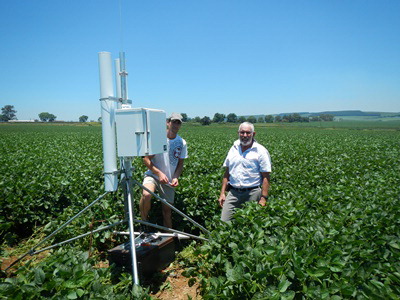PI: Colin Everson (University of KwaZulu-Natal)
U.S. Partner: Marek Zreda (University of Arizona)
Project Dates: August 2013 to February 2017

Dr. Colin Everson (right) and a student with the cosmic ray probe at the Baynesfield Estate in KwaZulu-Natal (Photo courtesy Dr. Everson).
|
Project OverviewThe vulnerability of South Africa to climate and environmental change is increasing as demands on resources continue to rise in conjunction with rapidly growing populations. Disaster management agencies will have to adapt to the increasing number of natural disasters, including droughts and floods. In addition, water resources management, crop modeling, and irrigation scheduling all require accurate, spatially distributed, daily estimates of soil water (SW) and total evaporation (ET) from catchment to national scale. This will only be feasible through remote sensing technologies, and it is therefore essential to further the development and integration of space-based technologies within already existing national disaster management plans.
This PEER project leveraged the development of the Cosmic Ray Probe (CRP) as part of a National Science Foundation-supported project. The CRP uses cosmic-ray neutrons to measure soil moisture content over an area of tens of hectares. The PI and his research team tested the suitability of a cosmic ray moisture probe in providing data for the continued support of soil moisture modeling of South Africa using a hydrologically consistent land surface model, accurate field and satellite-scale estimates of soil moisture for the calibration of hydrometeorological models, and estimation of the spatial variability of soil moisture at catchment scale.
This new technology can be employed in water demand forecasting and promises to improve the utilization of irrigation water, especially in water scarce regions like South Africa. The probe can also be used for predictive weather and climate models by measuring soil water content. The project improved the quality of soil moisture data that feed into the South African Flash Flood Guidance System, which provides alerts to the public based on current and predicted rainfall. The system currently uses a relatively crude evaporation model. Therefore, the application of CRP data should help in validating evaporation estimates with better temporal and spatial resolution, thus improving the accuracy of flash flood predictions.
Final Summary of Project Activities
Dr. Everson and his team selected three different sites with contrasting land uses for this study: agricultural crops at Baynesfield (soybean and maize) near Pietermaritzburg; natural grassland vegetation at Cathedral Peak in the KwaZulu-Natal Drakensberg; and commercial forestry at the Two Streams catchment, afforested with
Acacia mearnsii (Black wattle) in the KwaZulu-Natal midlands. The PEER team also purchased a CRP rover to obtain estimates at a scale suitable to validate remote sensing.
Cosmic ray probes were installed on tripod masts in each of the three research catchments, connected to a datalogger with an antenna used to send data via satellite link. The CRP estimates were validated against in-situ SW datasets to test the suitability of the CRP to provide spatial estimates of SW. At the Cathedral Peak Catchment site, the CRP followed the same seasonal trend as the in-situ SW estimates. The CRP correlated to the in-situ SW dataset better in the wetter periods, when the SW values were higher (above 30%) compared to the drier periods. Overall, this data correlated well with the in-situ SW dataset. The Satellite Applications and Hydrology Group (SAHG) SW was obtained in Standardized Soil Moisture Index format and converted to SW by using a representative porosity value. The SAHG SW estimates followed the same seasonal trend as the CRP estimates with a close correlation between the two datasets, in terms of general increases and decreases in SW content. The CRP had more variation in SW from day-to-day. The researchers also back-calculated SW from relative evaporation and evaporative fraction estimated using the Surface Energy Balance System (SEBS) model, but the SEBS model performed poorly against the CRP validation data.
The PI and team members presented methodology and findings of their studies through several technical presentations both in South Africa and internationally. The CRP equipment acquired through this PEER project has created a platform for a PhD student's ongoing doctoral studies. The team also was awarded a $20,000 grant for continued hydrometeorological monitoring at the Two Streams catchment.
PublicationsThigesh Vather, Colin S. Everson, and Trenton E. Franz. 2020. The applicability of the Cosmic Ray Neutron Sensor to simultaneously monitor soil water content and biomass in an Acacia mearnsii forest.
Hydrology 7: 48.
https://doi.org/10.3390/hydrology7030048 Thigesh Vather, Colin Everson, and Trenton E. Franz. 2019. Calibration and validation of the Cosmic Ray Neutron Rover for soil water mapping within two South African land classes.
Hydrology 6: 65.
https://doi.org/10.3390/hydrology6030065 T. Vather, C. Everson. M. Mengistu, and T. Franz. 2018. Cosmic ray neutrons provide an innovative technique for estimating intermediate scale soil moisture.
South African Journal of Science 114(7/8), Article #2017-0422, 9 pages.
http://dx.doi.org/10.17159/sajs.2018/20170422 C.S. Everson, M.G. Mengistu, and T. Vather. 2017. The validation of the variables (evaporation and soil water) in hydrometeorological models: Phase II, application of cosmic ray probes for soil water measurement. A report to the Water Research Commission, WRC Report No. 2323/1/17.
https://www.wrc.org.za/wp-content/uploads/mdocs/2323-1-171.pdf 



